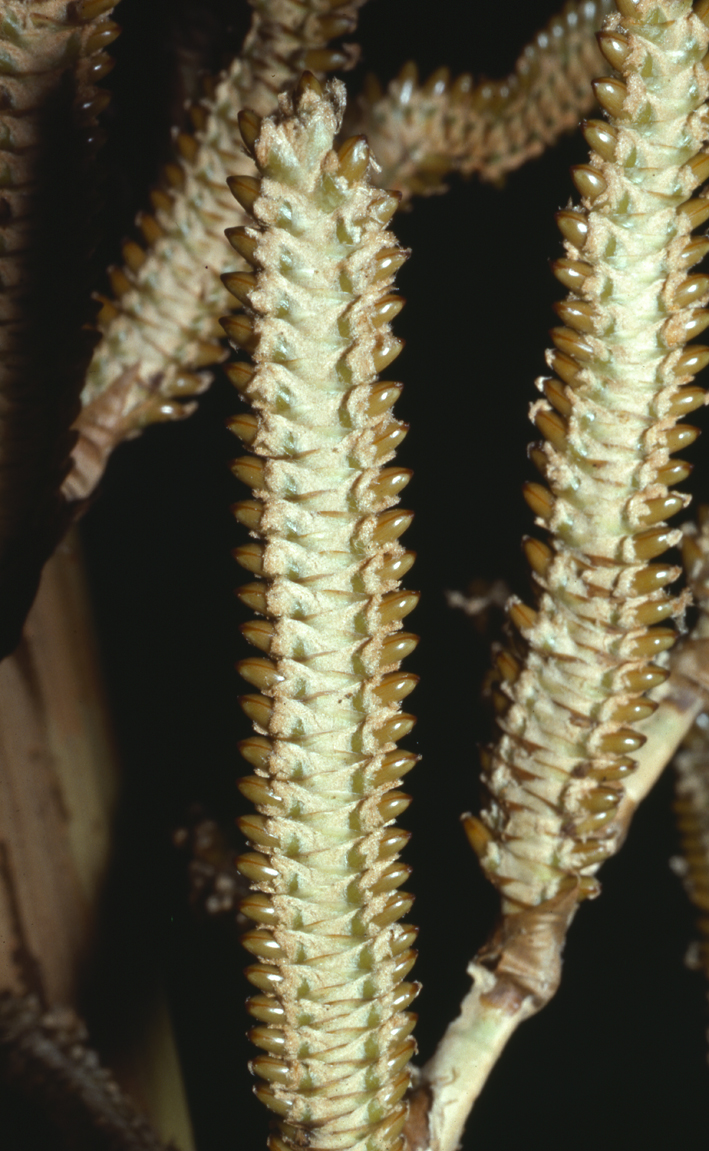- Acanthophoenix
- Acrocomia
- Actinokentia
- Actinorhytis
- Adonidia
- Aiphanes
- Allagoptera
- Ammandra
- Aphandra
- Archontophoenix
- Areca
- Arenga
- Asterogyne
- Astrocaryum
- Attalea
- Bactris
- Balaka
- Barcella
- Basselinia
- Beccariophoenix
- Bismarckia
- Borassodendron
- Borassus
- Brassiophoenix
- Burretiokentia
- Butia
- Calamus
- Calyptrocalyx
- Calyptrogyne
- Calyptronoma
- Carpentaria
- Carpoxylon
- Caryota
- Ceratolobus
- Ceroxylon
- Chamaedorea
- Chamaerops
- Chambeyronia
- Chelyocarpus
- Chuniophoenix
- Clinosperma
- Coccothrinax
- Cocos
- Corypha
- Cryosophila
- Cyphokentia
- Cyphophoenix
- Cyphosperma
- Deckenia
- Desmoncus
- Dictyocaryum
- Drymophloeus
- Dypsis
- Elaeis
- Eleiodoxa
- Eremospatha
- Eugeissona
- Euterpe
- Gaussia
- Geonoma
- Guihaia
- Hedyscepe
- Hemithrinax
- Howea
- Hyophorbe
- Hyospathe
- Hyphaene
- Iriartea
- Iriartella
- Itaya
- Jailoloa
- Johannesteijsmannia
- Juania
- Jubaea
- Jubaeopsis
- Kentiopsis
- Kerriodoxa
- Korthalsia
- Laccospadix
- Laccosperma
- Lanonia
- Latania
- Lemurophoenix
- Leopoldinia
- Lepidocaryum
- Lepidorrhachis
- Leucothrinax
- Licuala
- Linospadix
- Livistona
- Lodoicea
- Lytocaryum
- Manicaria
- Manjekia
- Marojejya
- Masoala
- Mauritia
- Mauritiella
- Maxburretia
- Medemia
- Metroxylon
- Myrialepis
- Nannorrhops
- Nenga
- Neonicholsonia
- Neoveitchia
- Nephrosperma
- Normanbya
- Nypa
- Oenocarpus
- Oncocalamus
- Oncosperma
- Orania
- Oraniopsis
- Parajubaea
- Pelagodoxa
- Phoenicophorium
- Phoenix
- Pholidocarpus
- Pholidostachys
- Physokentia
- Phytelephas
- Pigafetta
- Pinanga
- Plectocomia
- Plectocomiopsis
- Podococcus
- Pogonotium
- Ponapea
- Prestoea
- Pseudophoenix
- Ptychococcus
- Ptychosperma
- Raphia
- Ravenea
- Reinhardtia
- Retispatha
- Rhapidophyllum
- Rhapis
- Rhopalostylis
- Roscheria
- Roystonea
- Sabal
- Sabinaria
- Salacca
- Saribus
- Satakentia
- Satranala
- Schippia
- Sclerosperma
- Socratea
- Solfia
- Sommieria
- Syagrus
- Synechanthus
- Tahina
- Tectiphiala
- Thrinax
- Trachycarpus
- Trithrinax
- Veitchia
- Verschaffeltia
- Voanioala
- Wallaceodoxa
- Wallichia
- Welfia
- Wendlandiella
- Wettinia
- Wodyetia
- Zombia
- x Jubautia splendens
- ?? Acoelorrhaphe
- ?? Bentinckia
- ?? Brahea
- ?? Clinostigma
- ?? Colpothrinax
- ?? Copernicia
- ?? Cyrtostachys
- ?? Dictyosperma
- ?? Dransfieldia
- ?? Heterospathe
- ?? Hydriastele
- ?? Iguanura
- ?? Incertae sedis & excluded names
- ?? Loxococcus
- ?? Micronoma
- ?? Paripon
- ?? Pritchardia
- ?? Rhopaloblaste
- ?? Serenoa
- ?? Washingtonia

Discussion
- D. ruptilis var. ruptilis was found in lowland dipterocarp forest in Ulu Ingei at about 150 m elevation. This is an abundant and conspicuous rattan in Sabah and its rarity in Brunei and absence from Sarawak is remarkable. It is one of the most heavily armed of all rattans, the sheaths completely covered with fierce dark spines. (Dransfield, J. 1997: The Rattans of Brunei Darussalam)A
Etymology
- Breaking up irregularly, referring to the rachilla bracts (Dransfield, J. 1997: The Rattans of Brunei Darussalam)A
Uses
- Produces a large reddish cane of moderate quality, rarely very long. (Dransfield, J. 1997: The Rattans of Brunei Darussalam)A
Description
- Very massive, clustering rattan with stems to 10 m , often flowering when much less; stem without sheaths to 30 mm diam., with sheaths to 60 mm, internodes to c. 30 cm. Sheath dull green, but surface almost entirely obscured by abundant flat brittle black or pale-tipped spines, generally upward pointing (though smaller spines pointing in several directions), of lengths varying from 1-8 cm, and abundant reddish brown indumentum; spines around leaf sheath mouth erect, particularly large, almost papery, to 12 × 0.5 cm; knee present but obscured by the spines; ocrea inconspicuous. Leaf cirrate, very large, to 4 m, including petiole to 50 cm and heavily armed cirrus to 1.5 m; petiole densely armed with partial whorls of straw-coloured spines to 4 cm long, pointing in several directions and covered with pale to dark brown indumentum; leaflets c. 50 on each side of the rachis, regularly arranged but rather distant (to 10 cm), stiff, shiny dark green, usually longitudinally folded, the longest to 60 × 3 cm, unarmed except for a few marginal bristles near the tip. Inflorescences massive, to 2 m long, with up to 9 partial inflorescences to 45 cm, the male with very crowded rachillae, the female with lax ± divaricating rachillae; primary bracts dull brown, almost woody, to 70 cm, quickly falling at anthesis, armed with scattered black spines to 1.5 cm and abundant red brown indumentum; rachilla bracts all conspicuous, persistent, irregularly splitting giving a very characteristic bracteate appearance to the whole inflorescence; male rachilla to 8 cm bearing crowded strictly distichous flowers; female rachilla to 18 cm with rather distant subdistichous flowers. Immature fruit pale green, borne on reddish brown flower remains; mature fruit pale brown, ± oblong, to 22 × 14 mm with a conspicuous beak to 5 × 2 mm, the fruit covered in 15 vertical rows of shiny scales. Seed oblong, to 18 × 8 mm; endosperm deeply ruminate. Seedling leaf with 4 divergent, thick, dark green leaflets. (Fig. 29, Pl. 5C, 5D). (Dransfield, J. 1997: The Rattans of Brunei Darussalam)A
Materials Examined
- BEL: Melilas, Bt.Batu Patam, Dransfield J. 6577. (Dransfield, J. 1997: The Rattans of Brunei Darussalam)A
- Log in to post comments

